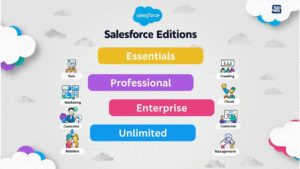Salesforce CRM & Its Architecture

In today’s customer-centric world, businesses thrive on strong relationships. This is where Customer Relationship Management (CRM) comes into play, and among the many CRM solutions available, Salesforce stands out as a global leader. But what exactly is Salesforce CRM, and how is it built to deliver such comprehensive functionality? Let’s explore.
What is Salesforce CRM?
Salesforce CRM is a cloud-based software company that provides a powerful platform for businesses to manage and enhance their interactions with current and potential customers. At its core, Salesforce helps organizations of all sizes build and improve customer relationships across various touchpoints, including sales, customer service, marketing, and e-commerce.
Think of it as a central hub where all customer data resides, providing a 360-degree view of every customer. This unified view empowers different departments to collaborate seamlessly, leading to:
- Improved Sales Efficiency: Sales teams can track leads, manage opportunities, automate tasks, and gain insights to close deals faster.
- Enhanced Customer Service: Service agents have access to complete customer history, enabling them to provide personalized and proactive support across multiple channels.
- Targeted Marketing Campaigns: Marketers can segment audiences, create personalized campaigns, and track their effectiveness.
- Streamlined Business Processes: Automation and workflows help businesses optimize operations and increase productivity.
- Data-Driven Decision Making: Robust reporting and analytics tools provide actionable insights into customer behavior and business performance.
- Scalability and Flexibility: As a cloud-based solution, Salesforce can grow with your business and be customized to meet specific needs.
Salesforce was a pioneer in delivering CRM as a cloud-based service, revolutionizing how businesses approached customer management. Today, it continues to innovate with the integration of Artificial Intelligence (AI) through features like Salesforce Einstein, which provides predictive intelligence, automation, and personalized recommendations.
The Architecture of Salesforce CRM: A Multi-Tenant, Metadata-Driven Powerhouse
The robust capabilities of Salesforce CRM are underpinned by a sophisticated and highly scalable architecture. Understanding this architecture is key to appreciating how Salesforce delivers its powerful features. The core principles of Salesforce’s architecture include:
- Multi-Tenant Architecture: This is perhaps the most fundamental aspect of Salesforce’s design. In a multi-tenant environment, multiple clients (or “tenants”) share the same infrastructure and a single instance of the software application. Imagine an apartment building where each tenant has their own apartment with their unique setup, but they all share the same building’s foundation, electricity, and plumbing.
- Benefits:
- Cost-Effectiveness: Sharing resources significantly reduces hardware and maintenance costs for individual businesses.
- Automatic Updates: Salesforce can deliver updates and new features to all customers simultaneously, ensuring everyone is on the latest version without disruption.
- Scalability: The platform can easily scale to support a massive number of users and data volumes.
- Security: Despite sharing infrastructure, each tenant’s data and customizations are securely isolated.
- Benefits:
- Metadata-Driven Development: Salesforce operates on a metadata-driven model, which means that the platform’s behavior and structure are defined by metadata rather than hard-coded solutions. Metadata is essentially “data about data” – it describes how objects, fields, customizations, and configurations work.
- Benefits:
- Rapid Customization: Developers and administrators can quickly modify applications by adjusting metadata without extensive coding. This allows for agile adaptation to changing business requirements.
- Seamless Upgrades: Customizations are preserved during platform upgrades because they are stored as metadata, separate from the core code.
- Declarative Development: Many functionalities can be built and configured using clicks, not code (e.g., Workflow Rules, Process Builder, Flows), making it accessible to a wider range of users. For complex logic, developers can use Apex (Salesforce’s proprietary programming language) and Visualforce.
- Benefits:
- Layered Platform: The Salesforce platform can be conceptualized as a series of layers, each providing specific functionalities:
- Data Layer: This is where all the customer data is stored. Salesforce uses a secure, shared database schema for all customers, with metadata ensuring data isolation. Objects (like database tables) and fields (columns) are the building blocks of the data model.
- Logic/Business Layer: This layer houses the business logic, which dictates how data is processed and how applications behave. This includes standard functionalities as well as custom logic built using declarative tools or Apex.
- User Interface (UI) Layer: This is what users interact with. Salesforce offers standard interfaces like Salesforce Classic and the modern Lightning Experience, which are highly customizable using Lightning Components and Visualforce.
- API Layer: Salesforce provides a rich set of APIs (Application Programming Interfaces) that enable seamless integration with external systems and applications. These APIs allow programmatic access to Salesforce data and functionality, supporting a wide range of integration patterns.
- Enterprise Ecosystem & AppExchange: Salesforce fosters a vibrant ecosystem of partners and developers. The Salesforce AppExchange is an online marketplace where businesses can discover, download, and install pre-built applications that extend Salesforce’s capabilities. This further enhances the platform’s flexibility and allows businesses to tailor their CRM solution to specific industry needs.
In essence, Salesforce’s architecture is designed for agility, scalability, and trust. By leveraging a multi-tenant, metadata-driven approach on a robust layered platform, Salesforce empowers businesses to build stronger customer relationships and drive growth in an increasingly competitive landscape.

